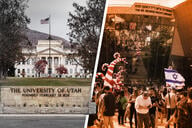You have /5 articles left.
Sign up for a free account or log in.
The students who earned bachelor's degrees from American colleges in 2007-8 were substantially less racially diverse than all undergraduates who were enrolled in college that year, a new report from the American Council on Education shows.
The report is the third in ACE’s series “Diversity Matters in U.S. Higher Education” series and is derived from data from the Department of Education.
The average 2007-8 graduate was white, single, childless, in his or her early 20s, and financially dependent on parents; the average graduate had started college at the age of 18.7 and had spent 5 years in college. Asian-American and white students were more likely than other ethnic and racial groups to be of “traditional age.” White students represented 73 percent of those receiving bachelor’s degrees, while they made up only 62 percent of the overall undergraduate student body and 61 percent of freshmen in 2003-4. Similarly, African Americans were 14 percent of both the freshman cohort in 2003-4 and of the undergraduate student body in 2007-8, but only 9 percent of 2007-8 bachelor’s-degree recipients.
Seventy-one percent of students earning a baccalaureate started at a four-year college or university, and 68 percent attended only one institution until graduation. Fifty-seven percent of graduates had a college-educated parent, and 57 percent had families with an annual income of more than $60,000.
The largest change in graduate demographics over the past three years has been in terms of gender, according to the report. Not only were 58 percent of graduates in 2007-8 female, but women made up the majority of every racial demographic among graduates, with the greatest majority found among African Americans (among whom they were 68 percent of graduates) and Hispanics (among whom they were 64 percent).
Unlike the racial demographics, the breakdown of women in the graduating class was reflected across the board: 58 percent of the 2003-4 freshman cohort were women, and 57 percent of the 2007-8 undergraduate student body were women.
The report also explored the graduates in relation to the labor market. Fifty-eight percent of graduates in 2007-8 were between jobs or fluctuating between participation and nonparticipation in the labor market; the racial group with the highest rate of continuous postgraduation participation in the labor force was Native Hawaiians/Pacific Islanders, with 50 percent, while the group with the lowest was Asian Americans, with 27 percent.
Mikyung Ryu, ACE’s interim director of the Center for Policy Analysis and author of the report, said in a news release that the demographic gaps were “a huge concern.”
“Given shifting student demographics, this gap will likely widen unless we undertake serious efforts to eradicate barriers for nontraditional and disadvantaged minority students,” Ryu said.




